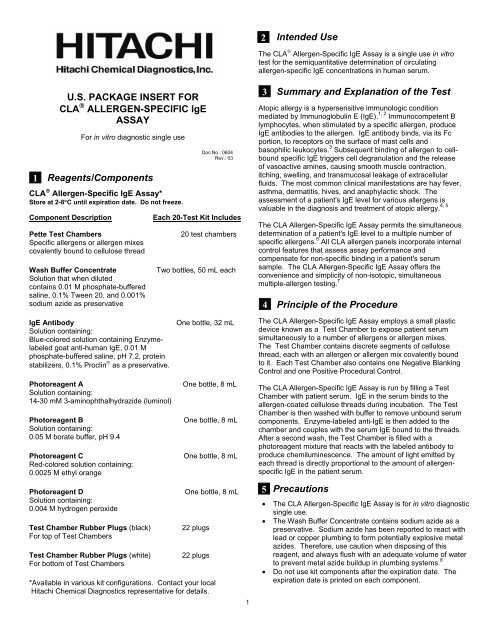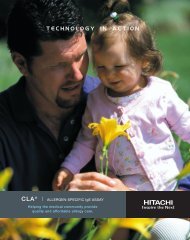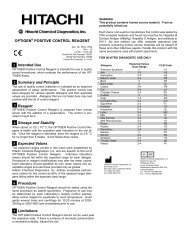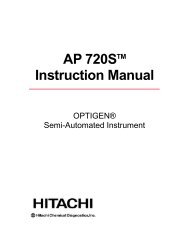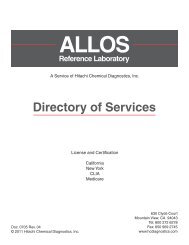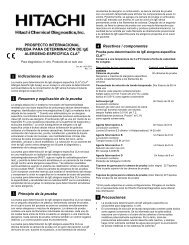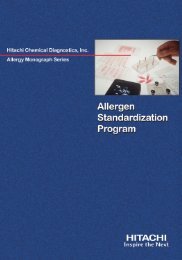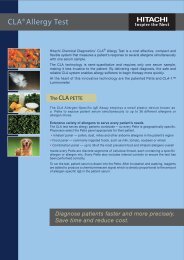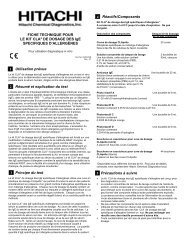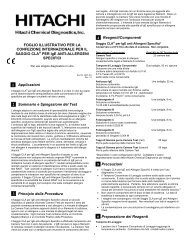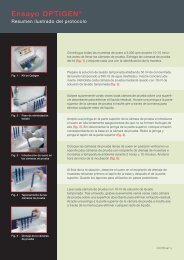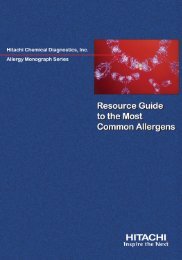CLA® Allergen-Specific IgE Assay Package Insert - Hitachi ...
CLA® Allergen-Specific IgE Assay Package Insert - Hitachi ...
CLA® Allergen-Specific IgE Assay Package Insert - Hitachi ...
Create successful ePaper yourself
Turn your PDF publications into a flip-book with our unique Google optimized e-Paper software.
2Intended UseThe CLA ® <strong>Allergen</strong>-<strong>Specific</strong> <strong>IgE</strong> <strong>Assay</strong> is a single use in vitrotest for the semiquantitative determination of circulatingallergen-specific <strong>IgE</strong> concentrations in human serum.1U.S. PACKAGE INSERT FORCLA ® ALLERGEN-SPECIFIC <strong>IgE</strong>ASSAYFor in vitro diagnostic single useReagents/ComponentsCLA ® <strong>Allergen</strong>-<strong>Specific</strong> <strong>IgE</strong> <strong>Assay</strong>*Store at 2-8°C until expiration date. Do not freeze.Component DescriptionPette Test Chambers<strong>Specific</strong> allergens or allergen mixescovalently bound to cellulose threadWash Buffer ConcentrateSolution that when dilutedcontains 0.01 M phosphate-bufferedsaline, 0.1% Tween 20, and 0.001%sodium azide as preservativeDoc.No.: 0604Rev.: 03Each 20-Test Kit Includes20 test chambersTwo bottles, 50 mL each<strong>IgE</strong> AntibodyOne bottle, 32 mLSolution containing:Blue-colored solution containing Enzymelabeledgoat anti-human <strong>IgE</strong>, 0.01 Mphosphate-buffered saline, pH 7.2, proteinstabilizers, 0.1% Proclin ® as a preservative.Photoreagent ASolution containing:14-30 mM 3-aminophthalhydrazide (luminol)Photoreagent BSolution containing:0.05 M borate buffer, pH 9.4Photoreagent CRed-colored solution containing:0.0025 M ethyl orangePhotoreagent DSolution containing:0.004 M hydrogen peroxideTest Chamber Rubber Plugs (black)For top of Test ChambersTest Chamber Rubber Plugs (white)For bottom of Test ChambersOne bottle, 8 mLOne bottle, 8 mLOne bottle, 8 mLOne bottle, 8 mL22 plugs22 plugs*Available in various kit configurations. Contact your local<strong>Hitachi</strong> Chemical Diagnostics representative for details.13Summary and Explanation of the TestAtopic allergy is a hypersensitive immunologic conditionmediated by Immunoglobulin E (<strong>IgE</strong>). 1, 2 Immunocompetent Blymphocytes, when stimulated by a specific allergen, produce<strong>IgE</strong> antibodies to the allergen. <strong>IgE</strong> antibody binds, via its Fcportion, to receptors on the surface of mast cells andbasophilic leukocytes. 3 Subsequent binding of allergen to cellboundspecific <strong>IgE</strong> triggers cell degranulation and the releaseof vasoactive amines, causing smooth muscle contraction,itching, swelling, and transmucosal leakage of extracellularfluids. The most common clinical manifestations are hay fever,asthma, dermatitis, hives, and anaphylactic shock. Theassessment of a patient's <strong>IgE</strong> level for various allergens isvaluable in the diagnosis and treatment of atopic allergy. 4, 5The CLA <strong>Allergen</strong>-<strong>Specific</strong> <strong>IgE</strong> <strong>Assay</strong> permits the simultaneousdetermination of a patient's <strong>IgE</strong> level to a multiple number ofspecific allergens. 6 All CLA allergen panels incorporate internalcontrol features that assess assay performance andcompensate for non-specific binding in a patient's serumsample. The CLA <strong>Allergen</strong>-<strong>Specific</strong> <strong>IgE</strong> <strong>Assay</strong> offers theconvenience and simplicity of non-isotopic, simultaneousmultiple-allergen testing. 74Principle of the ProcedureThe CLA <strong>Allergen</strong>-<strong>Specific</strong> <strong>IgE</strong> <strong>Assay</strong> employs a small plasticdevice known as a Test Chamber to expose patient serumsimultaneously to a number of allergens or allergen mixes.The Test Chamber contains discrete segments of cellulosethread, each with an allergen or allergen mix covalently boundto it. Each Test Chamber also contains one Negative BlankingControl and one Positive Procedural Control.The CLA <strong>Allergen</strong>-<strong>Specific</strong> <strong>IgE</strong> <strong>Assay</strong> is run by filling a TestChamber with patient serum. <strong>IgE</strong> in the serum binds to theallergen-coated cellulose threads during incubation. The TestChamber is then washed with buffer to remove unbound serumcomponents. Enzyme-labeled anti-<strong>IgE</strong> is then added to thechamber and couples with the serum <strong>IgE</strong> bound to the threads.After a second wash, the Test Chamber is filled with aphotoreagent mixture that reacts with the labeled antibody toproduce chemiluminescence. The amount of light emitted byeach thread is directly proportional to the amount of allergenspecific<strong>IgE</strong> in the patient serum.5• Precautions• The CLA <strong>Allergen</strong>-<strong>Specific</strong> <strong>IgE</strong> <strong>Assay</strong> is for in vitro diagnosticsingle use.• The Wash Buffer Concentrate contains sodium azide as apreservative. Sodium azide has been reported to react withlead or copper plumbing to form potentially explosive metalazides. Therefore, use caution when disposing of thisreagent, and always flush with an adequate volume of waterto prevent metal azide buildup in plumbing systems. 8• Do not use kit components after the expiration date. Theexpiration date is printed on each component.
• Component reagents of the CLA <strong>Allergen</strong>-<strong>Specific</strong> <strong>IgE</strong> <strong>Assay</strong>kits are provided as matched sets. Do not mix with other kitlot reagent sets.• Bleach contamination has been found to interfere with thetest.Reagent PreparationWash Buffer:• Allow Wash Buffer Concentrate to reach room temperature.Check to see that all salt crystals have dissolved.• Add contents of Wash Buffer Concentrate bottle (50 mL) to950 mL of distilled or deionized water in a clean 1 Lgraduated cylinder or flask. Mix thoroughly.• Transfer solution to Wash Buffer Dispenser.• Once prepared, the Wash Buffer solution can be used for upto 1 month when stored at room temperature (20-25°C) orrefrigerated (2-8°C).<strong>IgE</strong> Antibody:• Allow <strong>IgE</strong> Antibody to reach room temperature before use.Photoreagent Mixture:Prepare Photoreagent Mixture just before use.• Allow Photoreagents A, B, C, and D to reach roomtemperature.• Using a micropipette with disposable tips, combine equalparts of Photoreagent A, B, C, and D in a container. Aminimum of 350 μL of each Photoreagent is required perTest Chamber being assayed, i.e., 1.4 mL ofPhotoreagent Mixture per Test Chamber.• Gently swirl the container to mix.• Photoreagent Mixture should be used within 60 minutes ofmixing.76Storage Instructions• Store kit components at 2-8°C. When stored as directed,the components can be used until the expiration datesprinted on the individual component labels.• Do not freeze kit components.• The Test Chambers are packaged in a plastic bag with amoist sponge. Be sure the plastic bag is sealed properlybefore and after use. When stored in the sealed bag at2-8°C, Test Chambers can be used until the printedexpiration date.8Specimen Collection and PreparationHandle all patient samples and used kit components asrecommended for any potentially infectious human serum orblood specimen. Follow Universal Precautions or otherguidelines as established by your institution when handlingpatient specimens. 9-11The minimum volume of human serum required for each TestChamber is as follows:One 36-allergen Test Chamber, 1.4 mL of serumOne 16-or-fewer-allergen Test Chamber, 0.8 mL of serumCollect a venous blood sample into a 10 mL serum separatortube or red-top tube. Patient need not be fasting. No specialpreparations are necessary. Hemolyzed or lipemic serum mayadversely affect the performance of the CLA <strong>Allergen</strong>-<strong>Specific</strong><strong>IgE</strong> <strong>Assay</strong>. Serum samples may be stored at 2-8°C for up to2one week. For longer periods, store samples frozen at -20°C.Repeated freezing and thawing of serum samples should beavoided. Frozen samples that have been thawed should bethoroughly mixed before centrifugation.9<strong>Assay</strong> ProcedureRefer to the User Guide & Procedural Manual for detailedinstructions on test operation.Materials Provided• CLA <strong>Allergen</strong>-<strong>Specific</strong> <strong>IgE</strong> <strong>Assay</strong>• CLA Equipment Kit,• CLA-1 Luminometer SystemMaterials Required But Not Provided• Graduated cylinder or flask, 1 L, for preparing Wash Buffer• Deionized or distilled waterPreparation of Test Chambers and Patient SamplesRe-centrifuge serum samples for 10 to 20 minutes at2000-3000 x g immediately prior to use. Turn off the centrifugebrake prior to spinning the serum samples.1. Remove Test Chambers (one per specimen) from plastic bag.Reseal plastic bag and return unused Test Chambers torefrigerator.2. With colored grid facing down, label each Test Chamber withappropriate patient identification.3. Record kit lot numbers, panel lot numbers, and patientidentifications.4. Gently tap Test Chamber tip onto an absorbent paper towel toremove any residual liquid from inside the test chamber.ProcedureA. Fill Test Chambers with Serum:1. Attach the 3 cc syringe to top of Test Chamber.2. <strong>Insert</strong> bottom of Test Chamber into tube containingpatient serum. Avoid any precipitate and/or lipid layer.3. Slowly withdraw syringe plunger to draw serum into TestChamber until top thread is covered.B. Plug and Incubate Test Chambers:1. With syringe still attached to top of Test Chamber, inserta white plug into bottom of Test Chamber.2. Remove the syringe and insert black plug into top of TestChamber.3. Incubate upright in workstation rack at room temperaturefor 16 to 24 hours.C. Drain Serum:1. Remove bottom plug from each Test Chamber and placeTest Chamber back in workstation rack.2. Remove top plug from each Test Chamber, allowingserum to drain into workstation reservoir.D. Wash Test Chambers:1. Prime Wash Buffer dispenser until all air bubbles areremoved.2. Attach end of opened dispenser tubing to top of first TestChamber.3. Sequentially wash each Test Chamber once with 10 mLof Wash Buffer. Allow each Test Chamber to draincompletely before proceeding to next step.4. Repeat Step 3 two more times for a total of three washes.Test Chambers must be filled with Antibody Reagentimmediately after washing to avoid drying of threads.
E. Fill Test Chambers with Antibody Reagent:1. Gently tap bottom of Test Chamber tip on absorbentpaper towel to remove any remaining Wash Buffer.2. Attach the 3 cc syringe to top of the Test Chamber.3. Place bottom of Test Chamber into Antibody Reagentcontainer. Use disposable reagent cup to hold AntibodyReagent.4. Slowly withdraw syringe plunger to draw AntibodyReagent into Test Chamber until top thread is covered.F. Plug and Incubate Test Chambers:1. <strong>Insert</strong> white bottom plug into Test Chamber with syringestill attached to top of the Test Chamber.2. Remove syringe and insert black top plug.3. Store reagent-filled Test Chambers upright in workstationrack. Incubate at room temperature for 4 hours ± 15minutes.G. Drain Antibody Reagent:1. Remove bottom plug from each Test Chamber andplace each Test Chamber back in workstation rack.2. Remove top plug from each Test Chamber, allowingliquid to drain into workstation reservoir.H. Wash Test Chambers three (3) times as described in StepsE1 through E4.I. Prepare Photoreagent Mixture as instructed in Section 6,REAGENT PREPARATION. Immediately after the lastwash to avoid drying of threads.J. Fill Test Chambers with Photoreagent Mixture:1. Gently tap bottom of Test Chamber tip on absorbentpaper towel to remove any remaining Wash Buffer.2. Attach syringe to top of Test Chamber.3. Place bottom of Test Chamber into disposable cupcontaining Photoreagent Mixture.4. Slowly withdraw syringe plunger to drawPhotoreagent Mixture into Test Chamber untilchamber is completely filled to the top.K. Plug Test Chambers:1. <strong>Insert</strong> white bottom plug into Test Chamber withsyringe still attached to top of the Test Chamber.2. Remove syringe and insert black top plug.3. Wipe away any Photoreagent mixture from outside ofTest Chambers with a clean, damp, lint-free wipe.L. Allow all Test Chambers to incubate for 20 minutes beforereading in the Luminometer. All Test Chambers must beread within 60 minutes of introduction of photoreagent.M. To read results, refer to the User Guide and ProceduralManual.10Quality ControlA. Internal Control ThreadsEach Test Chamber contains a Positive Procedural Controland a Negative Blanking Control. These threads functionas internal indicators for each Test Chamber.Positive Procedural Control: The Positive ProceduralControl checks the performance of kit reagents. ThePositive Procedural Control must generate a readinggreater than or equal to 243 LUs in the CLA-1Luminometer.Negative Blanking Control: The Negative BlankingControl compensates for any nonspecific <strong>IgE</strong> binding thatmay occur. The Negative Blanking Control must generatea reading of less than or equal to 33 LUs in the CLA-1Luminometer.B. <strong>IgE</strong> Positive and Negative Control Sera<strong>Hitachi</strong> Chemical Diagnostics recommends testing with twolevels of serum controls: CLA <strong>IgE</strong> Positive Control Serumand CLA <strong>IgE</strong> Negative Control Serum. For instructions ontheir use and acceptability of results, refer to the CLA <strong>IgE</strong>Positive and Negative Control Sera <strong>Package</strong> <strong>Insert</strong>.Frequency of testing with control should be decided byeach laboratory according to regulatory agencies'requirements.11ResultsThe CLA-1 Luminometer measures the amount of light emittedby the threads in the Test Chambers. The luminometermeasures light emission in luminescence units (LUs). Tocalculate the patient's <strong>IgE</strong> response, the instrumentautomatically subtracts the emission level of the NegativeBlanking Control Thread from the emission level of eachspecific <strong>IgE</strong> thread. Class values are assigned from 0 to 4based on the amount of light emitted by the individual threadsin the Test Chamber. These values make up the CLA ClassAllergy Scoring System as seen in the table below.CLA Class Net LUs<strong>Allergen</strong>-<strong>Specific</strong> <strong>IgE</strong>Concentration4 >242 Very High3 143-242 High2 66-142 Moderate1 27-65 Low1/0 12-26 Very Low0 0-11 NondetectableClass values of 1/0 or above represent progressivelyincreasing concentrations of allergen-specific antibodies.Class 0 represents an absence of or nondetectable levels ofallergen-specific antibodies.12Limitations of the Procedure• Hemolyzed or lipemic serum may adversely affect theperformance of the CLA <strong>Allergen</strong>-<strong>Specific</strong> <strong>IgE</strong> <strong>Assay</strong>.• Definitive clinical diagnosis and/or dosage regimens forimmunotherapy should not be based solely on the resultsof any single diagnostic test, but should be made by thephysician after all clinical and laboratory findings areevaluated.• The CLA <strong>Allergen</strong>-<strong>Specific</strong> <strong>IgE</strong> <strong>Assay</strong> providessemiquantitative results. The method has no absolutestandard and has been arbitrarily assigned levels ofclassification.• Since the binding capacity for specific <strong>IgE</strong> antibody mayvary from allergen to allergen, similar classifications ofdifferent allergens do not necessarily imply clinicalequivalence.• When testing for food allergies, circulating <strong>IgE</strong> antibodiesmay not be detected if they are directed towards alteredforms of allergens (such as cooked, processed, ordigested) and the altered forms are not present in thesame form as those food allergens that are used in thistest. False-positive test results in persons who are testedfor food allergies may lead to inappropriate dietaryrestriction, while false-negative results in food-sensitive3
persons may result in anaphylactic reactions of varyingseverity.• When testing for inhalant allergies, false-positive resultsmay lead to improper medication of those persons. Falsenegativetest results may lead to lack of proper medicaltreatment.• If total <strong>IgE</strong> values are greater or equal to 500 IU/mL, lowlevelallergen-specific <strong>IgE</strong> response should be interpretedwith caution.• Reliable and reproducible results will be obtained whenthe assay procedure is carried out in complete accordancewith the product's instructions for use and adherence togood quality control procedures.• Bleach contamination has been found to interfere with thetest.Labware that has been decontaminated with bleachsolution should be rinsed thoroughly with distilled ordeionized water.• The use of alcohol-based solutions to disinfect theworkstation will result in cracking of the plastic andpremature failure of the workstation.13Expected ValuesThe CLA Classes were originally determined via scientific studiesto establish calibration curves using serum containing specific<strong>IgE</strong> antibodies to White Birch. The cutoff threshold betweenpositive and negative results was statistically established as twostandard deviations above the mean value of the normalpopulation. 6It is recommended that each laboratory establish its ownexpected reference range for the population of interest.14 Performance CharacteristicsA. Precision 12Within-<strong>Assay</strong>: Five replicates of four serum samples wererun in one batch. The average mean coefficient of variationof the responses of all the allergens tested, when calculatedas net LUs, was 11.7%.Between-<strong>Assay</strong>: Five replicates of four serum sampleswere run on four different days. The mean coefficient ofvariation of the responses of all allergens tested, whencalculated as net LUs, was 11.6%.B. Sensitivity 12The detection limit of the assay is 10 LUs.C. <strong>Specific</strong>ity 12There is


